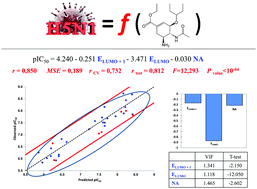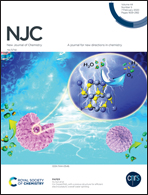QSAR study of N-substituted oseltamivir derivatives as potent avian influenza virus H5N1 inhibitors using quantum chemical descriptors and statistical methods†
Abstract
In silico modelling studies were executed on thirty two N-substituted oseltamivir derivatives as inhibitors of influenza virus H5N1. Robust validated quantitative structure–activity relationship (QSAR) approaches have been investigated to explore the important structural requirements essential to design potent anti-influenza virus H5N1 inhibitors. Density functional theory (DFT) calculations with the Becke three-parameter Lee–Yang–Parr B3LYP hybrid functional employing the 6-31G(d) basis set are used to calculate quantum chemical descriptors. The dataset was randomly divided into training and test sets comprising 25 and 7 compounds, respectively. Twenty models were established by changing the compounds of the sets and further were applied to calculate the predicted pIC50 values of the 7 compounds in the test set. All constructed models were individually validated internally as well as externally along with y-randomization according to the OECD principles for QSAR model validation and Golbraikh and Tropsha's criteria of model acceptance. Model 5 is selected with higher R2, Rtest2 and Qcv2 values (R2 = 0.902, Radj2 = 0.888, MSE = 0.094, Rtest2 = 0.872, Qcv2 = 0.857). It is very interesting to find that the anti-influenza H5N1 activity of these compounds appears to be mainly governed by three molecular descriptors, i.e. the lowest unoccupied molecular orbital energy (ELUMO), the energy of the molecular orbital below the HOMO (EHOMO−1) and the number of atoms (NA). Here the possible mechanism of action of these compounds was analysed and discussed; in particular, important structural requirements for enhanced H5N1 virus inhibitor activity could be reached by reducing the molecular size and introducing stronger electron accepting ability groups with small atoms and more protons into the N-substituted oseltamivir derivatives. Based on the best proposed QSAR model, some new compounds with higher neuraminidase inhibitor activity have been theoretically designed. Such results can offer useful theoretical references for future experimental work.



 Please wait while we load your content...
Please wait while we load your content...